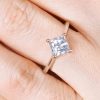It seems like people who are getting engaged are coming up with ever more elaborate ways to propose and more fantastical engagement rings. One very interesting engagement ring trend is replacing the diamond in the engagement ring with the birthstone of the bride. Well, except for future brides born in April, whose birthstone is the diamond.
While it may sound amazing and very thoughtful as a way to break away from the mold, not all birthstones are suitable for engagement rings. Some stones simply do not possess the hardness required from a stone in an engagement ring. Engagement ring stores and experts who work there may be able to persuade you.
Moh’s Scale of Mineral Hardness
The way experts determine the hardness of a stone is by using the Moh’s scale of mineral hardness. This scale goes from 1 to 10, with 1 being the softest mineral – talc, whereas the 10 is reserved for diamonds, which are the hardest natural substance known to us. Essentially this scale tells you how easy it is to damage the mineral with a harder substance. When it comes to the hardness of a stone for an engagement ring, anything under 7.5 on this scale is not suitable.
However, Moh’s scale is not the only factor you should consider when choosing a stone for your engagement ring. There are other things you need to consider, like toughness and the cut you want. Not all stones can be cut in shapes traditionally associated with engagement rings. For instance, emeralds have the hardness of 8, which would put them well into the acceptable zone. However, due to their tendency of having cavities and other imperfections inside of them, they are too fragile to be suitable for an engagement ring.
Ring types like https://emersonandfarrar.com/pages/die-struck-engagement-rings tend to be pretty robust and durable, so they require hard stones to complete them.
Which Months’ Birthstones Are Unsuitable?
There are months which have more than one stone, so there are more than twelve options to choose from. However, some months have the bad fortune to have no birthstones suitable for engagement rings.
Right from the start, both January and February have only one birthstone, garnet for the former and amethyst for the latter. Sadly, both of these fantastic looking stones fall short on the Moh’s scale, making them unsuitable for engagement rings.
June has three birthstones – moonstone, alexandrite, and pearl. However, both pearl and moonstone are too fragile and soft to be considered for engagement rings. (modafinil online purchase) August is fairly similar in that regard; out of the three birthstones (sardonyx, peridot, and spinel), only the last one is hard enough to take the rigors of being a part of an engagement ring.
October has two birthstones – tourmaline and opal, but they are both too soft and not suitable to adorn the engagement rings. November also has two stones, topaz, and citrine, but although citrine is too soft, topaz is perfectly suitable for this purpose.
Finally, December is a particularly rich month with four birthstones – blue zircon, tanzanite, turquoise, and blue topaz. Despite this apparent abundance, only the last one is of sufficient hardness, although blue zircon is considered a valid choice by some, with 7.5 on the Moh’s scale.
Suitable Birthstones
That leaves you with plenty of options when it comes to birthstones. March’s aquamarine is beautiful and hard enough. Alexandrite is a suitable June birthstone, whereas July’s ruby falls comfortably into this category, as does September’s sapphire, both with the value 9 on Moh’s scale.
However, even though these stones are not considered ideal for engagement rings, they can still be used as accent stones and complement a more suitable and durable stone. Ultimately, it is your engagement ring and your decision.
Learn more about Car Service to Newark Airport from NYC newarkairportcarservice at newarkairportcarservice





![Choosing a Diamond Ring [A Quick Run Through] Choosing a Diamond Ring](https://www.blushedrose.com/wp-content/uploads/2022/01/sabrianna-XEyyCJKg4yI-unsplash-100x100.jpg)

